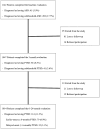Differential predictors of early- and delayed-onset post-traumatic stress disorder following physical injury: a two-year longitudinal study
- PMID: 38751413
- PMCID: PMC11094222
- DOI: 10.3389/fpsyt.2024.1367661
Differential predictors of early- and delayed-onset post-traumatic stress disorder following physical injury: a two-year longitudinal study
Abstract
Objectives: This study aimed to investigate the predictors of both early- and delayed-onset PTSD over a 2-year period following physical injuries.
Methods: Patients were recruited from a trauma center at a university hospital in South Korea (June 2015 ~ January 2021). At baseline, 1142 patients underwent comprehensive assessments including socio-demographic, pre-trauma, trauma-related, and peri-trauma evaluations. Diagnoses of acute stress disorder (ASD) and subthreshold ASD were also determined using the Clinician-administered PTSD Scale (CAPS). Follow-up assessments at three months included diagnoses of PTSD and subthreshold PTSD using CAPS, and stressful life events (SLEs), with additional evaluations at 6, 12, and 24 months. The analyzed sample comprised 1014 patients followed up at least once after the baseline and 3-month evaluations. PTSD diagnoses were categorized into early-onset (within the first six months after trauma) and delayed-onset (more than six months after trauma). Logistic regression models identified predictors for each group.
Results: Early-onset and delayed-onset PTSD were diagnosed in 79 and 35 patients, respectively. Early-onset PTSD was predicted by previous psychiatric disorders, previous traumatic events, ASD and subthreshold ASD diagnoses, and higher anxiety levels. In contrast, delayed-onset PTSD was linked to higher education, higher injury severity, and subthreshold PTSD and SLEs at 3-month follow-up.
Conclusion: Distinct predictors were found for early-onset and delayed-onset PTSD. The findings underscore the heterogeneous factors influencing the temporal development of PTSD post-trauma, and may provide valuable guidance for more targeted interventions and improved patient outcomes.
Keywords: delayed onset; longitudinal study; posttraumatic stress disorder; prediction; trauma injury.
Copyright © 2024 Kang, Kim, Kang, Jang, Kim, Lee, Kim, Shin and Kim.
Conflict of interest statement
The authors declare that the research was conducted in the absence of any commercial or financial relationships that could be construed as a potential conflict of interest.
Figures
Similar articles
-
Predictors of 2-Year Trajectory of Post-Traumatic Stress Disorder Following Physical Injury.Depress Anxiety. 2024 Sep 2;2024:5570405. doi: 10.1155/2024/5570405. eCollection 2024. Depress Anxiety. 2024. PMID: 40226687 Free PMC article.
-
Assessing the Predictive Validity of Early Post-injury CAPS-5 for Later Posttraumatic Stress Disorder Diagnosis.J Clin Psychiatry. 2024 Aug 5;85(3):24m15267. doi: 10.4088/JCP.24m15267. J Clin Psychiatry. 2024. PMID: 39145677
-
Interplay of serum BDNF levels and childhood adversity in predicting earlier-onset post-traumatic stress disorder: A two-year longitudinal study.J Anxiety Disord. 2024 Dec;108:102943. doi: 10.1016/j.janxdis.2024.102943. Epub 2024 Nov 12. J Anxiety Disord. 2024. PMID: 39546985
-
[Posttraumatic stress disorder (PTSD) as a consequence of the interaction between an individual genetic susceptibility, a traumatogenic event and a social context].Encephale. 2012 Oct;38(5):373-80. doi: 10.1016/j.encep.2011.12.003. Epub 2012 Jan 24. Encephale. 2012. PMID: 23062450 Review. French.
-
Evaluation of post-traumatic stress disorder (PTSD) and related comorbidities in clinical studies.J Med Life. 2022 Apr;15(4):436-442. doi: 10.25122/jml-2022-0120. J Med Life. 2022. PMID: 35646173 Free PMC article. Review.
Cited by
-
Predictors of 2-Year Trajectory of Post-Traumatic Stress Disorder Following Physical Injury.Depress Anxiety. 2024 Sep 2;2024:5570405. doi: 10.1155/2024/5570405. eCollection 2024. Depress Anxiety. 2024. PMID: 40226687 Free PMC article.
References
-
- Beierl E, Böllinghaus I, Clark D, Glucksman E, Ehlers A. Cognitive paths from trauma to posttraumatic stress disorder: a prospective study of Ehlers and Clark's model in survivors of assaults or road traffic collisions. Psychol Med. (2019) 50:2172–81. doi: 10.1017/S0033291719002253 - DOI - PMC - PubMed
LinkOut - more resources
Full Text Sources
Miscellaneous



